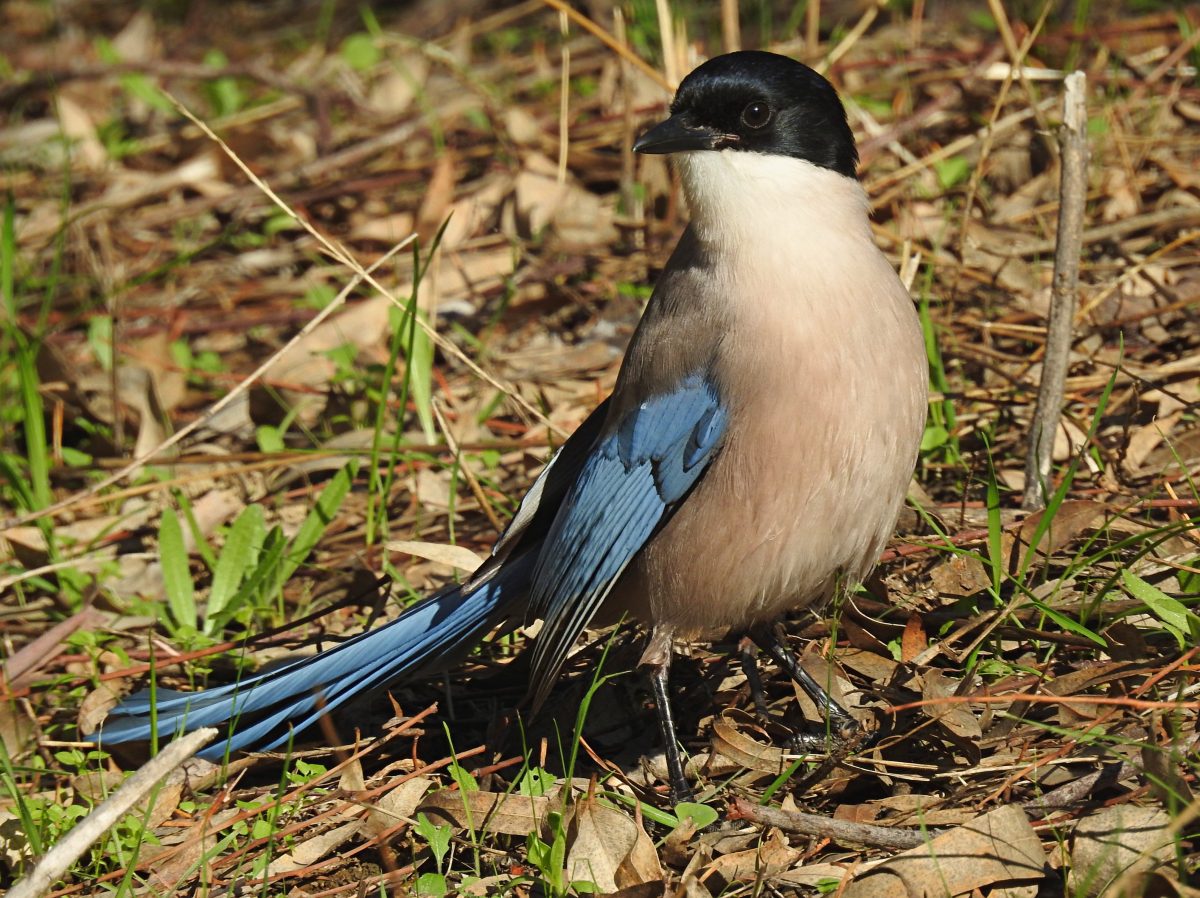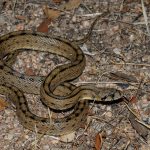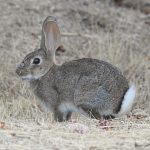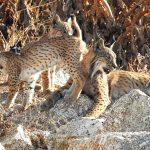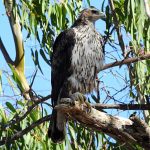There are dozens of different species of Mediterranean scrubland birds, but in order not to extend too much, here I show you the most significant ones.
Black redstart Phoenicrurus ochruros
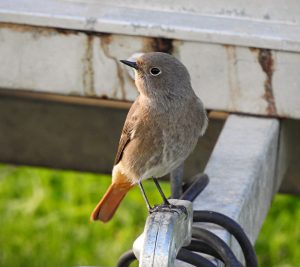
The size of a sparrow, it is characterized by its dark gray color and reddish tail. It nests in areas with rocks, cliffs, crags… but also in human constructions, since it tolerates the presence of man quite a lot. Present all year round in the region, its population increases in winter due to micro-migrations from more northern regions. It lives in crops, livestock areas, pastures… and feeds mainly on insects.
Carrion crow Corvus corone
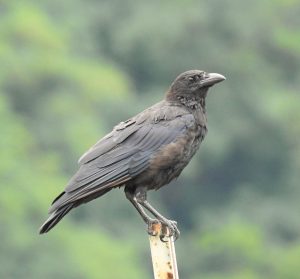
After the common raven, it is the second largest corvid. Abundant throughout the Iberian Peninsula, it is not especially frequent in Extremadura. We can observe it sometimes in open areas, pastures, cultivated fields… Apart from its size, which is noticeably smaller, it is easily distinguished from the raven in flight, as it flaps more frequently and hovers less. Like all corvids, it is an excellent opportunist and will take advantage of any occasion to feed, be it animal or vegetable food.
Common blackbird Turdus merula
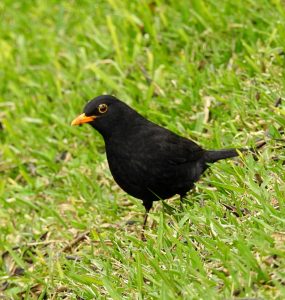
One of the most typical inhabitants of our towns and cities, unlike the sparrow can survive perfectly away from human presence. It differs from the also abundant starling by its yellow beak and much longer tail. Its natural habitats are the banks, meadows, bushes… It can also live in fruit crops, orchards, parks and gardens. The blackbird feeds on worms, worms and insects as well as all kinds of fruits and berries. Very abundant in Extremadura, it is distributed throughout the region.
Common house martin Delichon urbicum
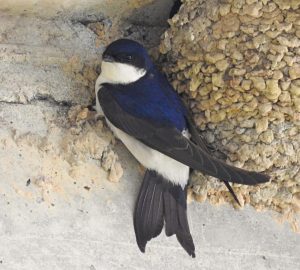
Of all martin, it is the most urban and is reproduced mainly on building cornices, although it can also be reproduced on large bridges. It is an insectivorous bird that visits us in the hot season to reproduce and feeds on insects it captures in flight. The common house martin is easily identified by its white bishop. Its population is numerous, stable and does not suffer great threats. They can be seen in practically any town in Extremadura and form important colonies on some of the bridges of the large reservoirs.
Common linnet Linaria cannabina
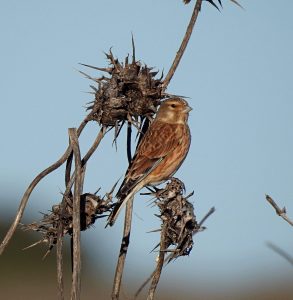
The linnet is widely distributed throughout Spain and is also frequent in Extremadura. Gregarious, they make partial migrations in the winter months towards areas with warmer temperatures. In Extremadura, therefore, the population increases during the winter months. It feeds mainly on seeds, although during the breeding period insects form an important part of its diet. It has a preference for open areas, whether woodland or scrubland, almost always near cereal crops.
Common pheasant Phasianus colchicus
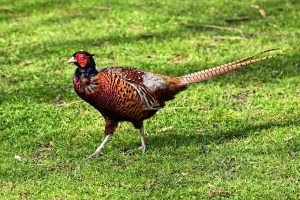
The pheasant is not a bird native to the country, but we can occasionally see specimens, mainly from hunting releases. It is a good-sized hen, with significant sexual dimorphism between the male and female, which likes to inhabit mosaics of copses and crops. There are currently some feral populations, although they are rather scarce. The best places to observe them are those hunting grounds where they are frequently released.
Common starling Sturnus vulgaris
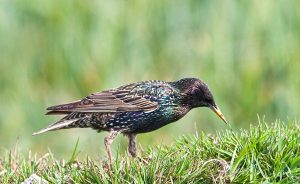
Like the black starling, it is a very common bird in all types of ecosystems. Traditionally in Extremadura it was a hibernating bird but there is a growing breeding population throughout the Peninsula. In winter, large flocks arrive in the region from central and northern Europe. It differs from the black starling in that its plumage is mottled with yellowish-white spots, especially visible in winter. Like the black starling, its presence is closely linked to human activity and its diet is very similar.
Common swift Apus apus
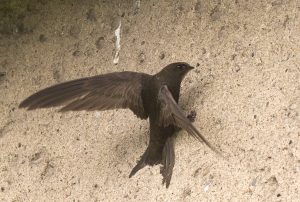
It is greyish brown in colour, only its slightly whitish throat stands out. Large fliers, they capture all the insects that they feed on in the air, being able to get to sleep in flight. In the breeding season they use holes in all kinds of buildings or even palms to nest. Present in spring and summer in the region, their strident shrieks flood the villages with sound at sunset. Their great ability to fly allows them to spread out over all kinds of habitats, the only condition being the availability of nesting places in the breeding season.
Common wood pigeon Columba palumbus
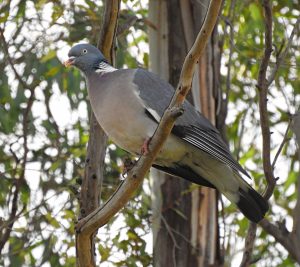
Another of the typical birds of the Mediterranean scrubland, very abundant in the holm oak and cork oak groves of Extremadura. There is an important resident and breeding population, which is reinforced by tens of thousands of individuals that come in winter from northern European countries. On occasions we can witness flocks of hundreds or even thousands of individuals during the migratory season. It is one of the species that, despite being considered a hunting species, continues to increase its population. In addition, in recent decades it has colonised many parks in towns and cities, tolerating human presence.
Dartford warbler Sylvia undata
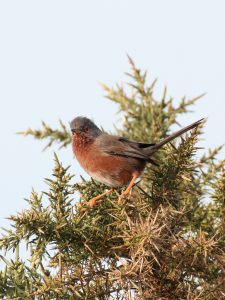
Small-sized warbler, it is unmistakable by its colors: dull blue back and wine colored chest and belly. It also has a very long tail, generally upright, and is closely linked to the dense Mediterranean scrub. Present all year round in Extremadura, it feeds on insects in spring and summer, changing to fruits and seeds in autumn and winter. Its habitat is expanding (mainly rockrose and heather thickets), so its populations are not threatened.
Eurasian collared dove Streptopelia decaocto
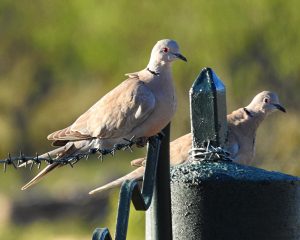
Slightly larger than the european turtle dove, despite not being native to the region or the country, there have been stable and growing populations for several decades. It adapts incredibly well to almost all types of habitat and also to human presence. This dove feeds mainly on seeds and cereal grains and is frequently seen in parks and gardens. Even though we have included it among mediterranean scrubland birds, it is almost always found in anthropised environments and can lay several clutches a year.
Eurasian hoopoe Upupa epops
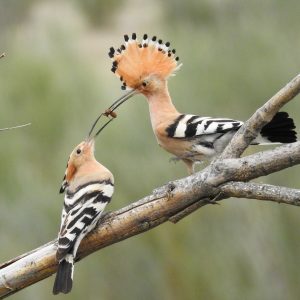
Another insectivorous bird with striking colors, it nests in cavities in walls or dry trees. Its chicks have a curious defense mechanism whereby they spray a very foul-smelling liquid at any predator that tries to enter the nest. It is present all year round in Extremadura (in the northern half of Spain it is migratory). It is characterized by a long crest along its entire head and its black and white wings. The hoopoe frequents pastures, crops, and areas with sparse trees. It is distributed throughout the region in the ecosystems mentioned above and feeds on all kinds of invertebrates.
Eurasian magpie Pica pica
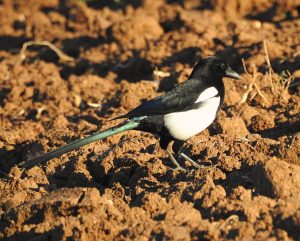
It is one of the most intelligent, if not the most intelligent, of the Mediterranean scrubland birds and is characterised by an incredible capacity to adapt. The eurasian magpie has conquered all kinds of habitats, including towns and cities in which its population has skyrocketed. Its black and white colours make it unmistakable and it is especially abundant in meadows, riverside woods and urban parks. It feeds mainly on small vertebrates, eggs, fruit, carrion… and can associate to hunt in groups larger prey such as small rabbits. Present all year round in the region, the population increase year after year.
Eurasian tree sparrow Passer montanus
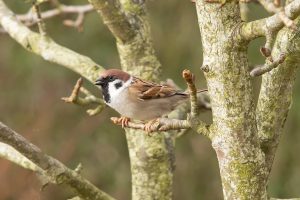
It is the smallest of the sparrows and, being more delicate than other species, its population trend is declining. It is the most forest-dwelling of all sparrows, but still prefers open woodland. Abundant throughout the region, its preferred habitats are crop fields with trees, parks, orchards and the outskirts of towns and cities wherever there are trees. Similar in colouring to the house sparrow, its “hood” is brown, with a black spot on the cheek and a whitish collar interrupted at the nape of the neck. Females have virtually identical plumage to males.
European bee-eater Merops apiaster
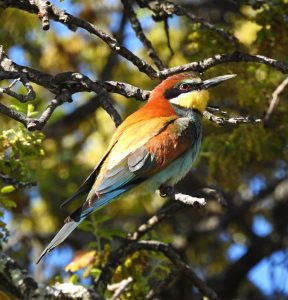
Slightly larger than a backbird, this bird is one of the most beatiful mediterranean scrubland birds. It floods the countryside with its typical song during the spring and summer months. It usually arrives at the end of March / beginning of April in Extremadura. The european bee-eater feeds on insects and flies over all kinds of ecosystems in search of flying insects that it catches with its acrobatic flights. It nests in galleries excavated in earthen slopes, generally near rivers. It is abundant throughout the community and although the use of insecticides is having a negative impact on their populations, it is still abundant.
European goldfinch Carduelis carduelis
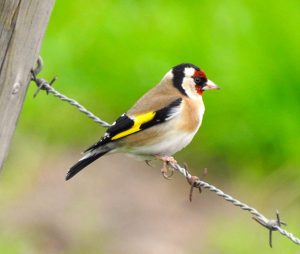
Another of the most common Mediterranean scrubland birds, it is clearly unmistakable by its red face and black and white head bands. Its song is very pleasant so some specimens are captured and caged. Present all year round in the region, its typical diet is thistle seeds although it complements it with flower buds and other seeds. It adapts to a large number of habitats provided there is some woodland. It sometimes forms mixed groups with other species: linnets, serins or greenfinches.
European robin Erithacus rubecula
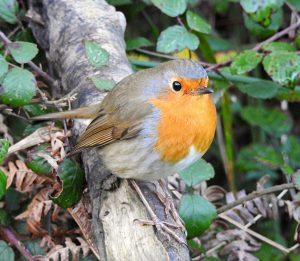
A little smaller than a sparrow, it is characterized by its orange-red chest and its melodious songs. In winter it is present throughout the region but only breeds in the northern third. In winter we can find it in all types of Mediterranean environments, even settling in parks and gardens. Mainly insectivorous, it can also feed on small fruits and seeds.
European serin Serinus serinus
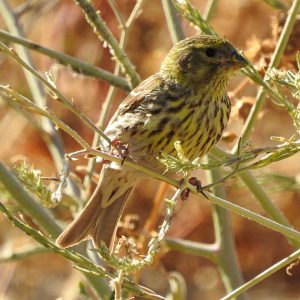
Small passerine, common throughout the Iberian Peninsula and also in Extremadura throughout the year. Being a partial migrant, in winter Extremadura hosts populations from more northern regions, both in Spain and the rest of Europe. Very common in olive groves and citrus crops, it can be found in practically any open forest, as long as it is not at high altitude. It feeds mainly on seeds, although it also feeds seasonally on fruits and insects. Easily identifiable by its yellowish-brown colors, it could only be confused with the eurasian siskin (it has yellowish-green bands that the serin does not have) or with the citril finch, which generally inhabits higher altitudes.
European turtle dove Streptopelia turtur
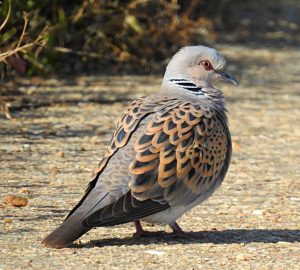
This small “pigeon” is one of the species whose populations have been most drastically reduced in recent decades. It was one of the most abundant Mediterranean scrubland birds. Loss of habitat, agricultural practices that do not benefit it at all and excessive hunting pressure have made this once-abundant species increasingly rare. A typical inhabitant of grasslands, crops and riverbanks, in late summer it feeds almost exclusively on grain in the stubble fields to gather fat for its migration to Africa. It is present throughout the community.
Fieldfare Turdus pilaris
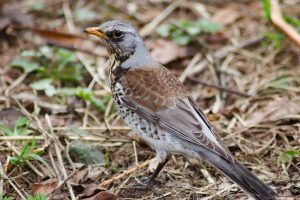
A large thrush, similar in size to the Mistle Thrush, from which it is clearly differentiated by its totally different colouring. It has a bluish-grey head and obisk, a greyish-brown back and a lighter, spotted breast. Not very common in Extremadura, it can be found in different types of habitat. Pastures, scrubland, crops, parks… although also deciduous and coniferous forests. It feeds mainly on fruits and berries and in summer migrates to northern Europe to breed. It also suffers some hunting pressure, although less than its congeners due to its more wooded habits.
Iberian grey shrike Lanius meridionalis
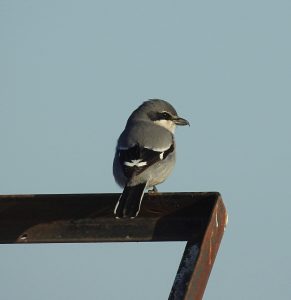
The biggest shrike present in the Iberian Peninsula. It differs from the common one in that its entire back is grey and it is much larger. It has the same predatory behaviour as the common one, although it is capable of capturing much larger prey. This shrike also tends to impale them on natural or artificial thorns to tear them apart or simply as a food source. The great grey shrike is accustomed to alighting on light poles and platforms with a certain height from which it can see its possible prey. It is a sedentary species whose populations have also suffered a notable decline, despite which it is still present throughout the region.
Iberian magpie Cyanopica cooki
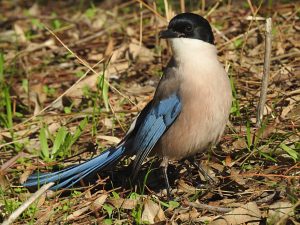
Corvid of small size but very colourful, it stands out for its long blue tail, as well as the end of its wings. It travels in large groups in search of food, feeding on all kinds of fruits and invertebrates, although it does not make small reptiles or birds look bad either. Few birds in the Mediterranean scrubland have a better ability to adapt. It is very abundant in practically all the pastures, fruit crops, olive groves, vineyards, banks and pine forests of the community.
House sparrow Passer domesticus
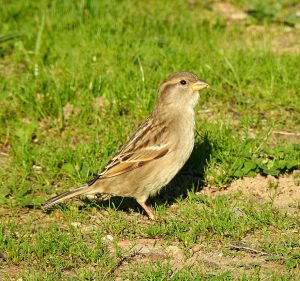
Probably the most frequent bird in the Iberian Peninsula, it has evolved in such a way that its existence is totally linked to human being. This dependence is such that when a village becomes unpopulated, the sparrows soon disappear. It is the urban and rural bird par excellence, reproducing in the urban areas themselves and feeding in the surroundings. It is mainly a granivorous bird, although it does not disdain fruit, food waste, insects… and we find it all over the region.
Meadow pipit Anthus pratensis
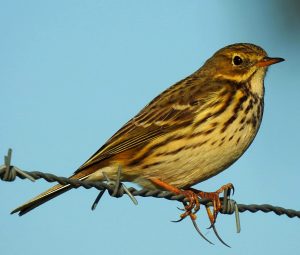
The size of a sparrow, it is present in irrigated crops, grasslands and other open spaces with few trees. Its cryptic plumage makes it camouflage very well with the ground and is difficult to locate. Present in Extremadura during winter, it feeds on small invertebrates and some seeds. Globally its population is in decline but in Extremadura it is not threatened.
Mistle thrush Turdus viscivorus
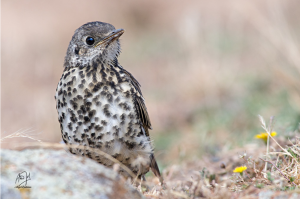
Larger than the common thrush (more than twice as large), and with a slightly duller back, it is easily identified. We find it in forests not too dense with oaks, holm oaks, cork oaks, pines and chestnut trees. It feeds on both invertebrates and small fruits and despite being a hunting species its populations are not threatened. It is distributed throughout the region, being a little more scarce in the southern half of the province of Badajoz.
Pallid swift Apus pallidus
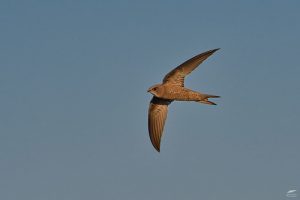
Very similar to the common swift, it differs from the common swift in having lighter, browner colours and a lighter throat. Its songs are quite different and can be a good method of identification in low light conditions. With gregarious habits, it can be seen in practically any habitat, generally with sparse woodland. It is a summer bird in the region, although the first specimens arrive in February and the last ones leave at the end of October. The pallid swift usually nests in large buildings in urban areas, although it can also use cliffs or other buildings. It feeds mainly on flying insects.
Red-backed shrike Lanius collurio
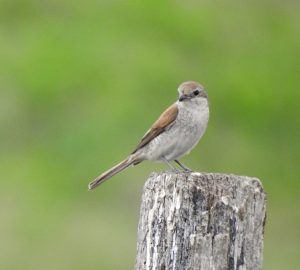
This shrike winters in Africa and breeds mainly in Europe. Although it is more typical of northern Spain / Europe, we can see some pairs in Extremadura during the breeding season. Like other shrikes, it likes to live in open spaces with thorny thickets, so we include it among Mediterranean scrubland birds. Similar in size to the Woodchat Shrike, it is rather less frequent. It can be found mainly in the north of Cáceres and especially the male has very marked colors. It feeds mainly on insects and small vertebrates.
Red-legged partridge Alectoris rufa
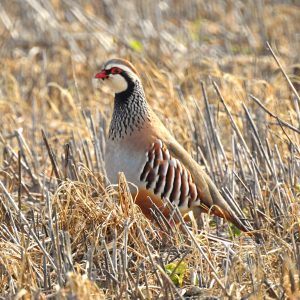
A key part of Extremadura’s ecosystems, due to the scarcity of rabbits in some areas it has become one of the main prey for some threatened predators. Although it adapts to all kinds of environments, it has a predilection for ecotones between the Mediterranean scrubland, pastureland, steppes and dry farming, where it often feeds. It is usually found in groups ranging from 3 or 4 to 20 individuals. It is especially abundant where it does not suffer great hunting pressure and is distributed throughout the region.
Red-rumped swallow Cecropis daurica
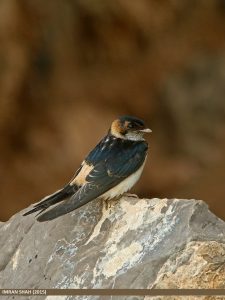
Similar to the barn swallow, it differs from it by its ochre spots on the back of the neck and just above the bishop’s head, which is whitish as in the common plane. Much less abundant than the common swallow, it is also less associated with rural environments, building its nests on bridges and buildings. It is insectivorous and particularly abundant on the Tajo and Almonte bridges at Alcántara lake. It can also be seen in Siberia in the García Sola cliffs.
Redwing Turdus iliacus
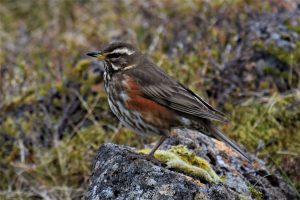
A small thrush, very similar to the common thrush, from which it differs mainly in that it has a reddish band on its breast. Its populations are fairly abundant, although they are under great hunting pressure and their future is uncertain. A regular inhabitant of vineyards, olive groves and other crops in the Mediterranean scrubland, it visits our region in autumn and migrates in spring. It adapts to many types of habitat, as long as there are scattered shrubs and trees.
Rock bunting Emberiza cia
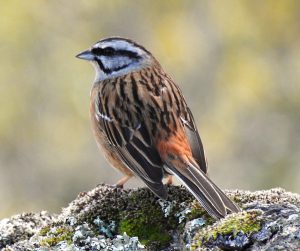
Similar in size to a sparrow, it is characterized by its brown back and 3 black stripes on its head, which are gray. It lives on slopes with low, thorny scrub, with some scattered trees. It is distributed throughout Extremadura, whenever we find these habitats. The rock bunting feeds mainly on seeds and shoots, although it can also eat insects. It is present all year round and frequent in the ecosystems it inhabits, and currently has no conservation problems.
Rufous-tailed scrub robin Cercotrichas galactotes
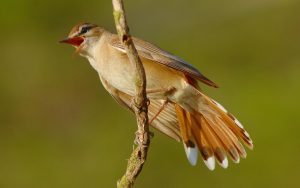
The size of a sparrow and reddish-brown with an orange tail, it is often lifted, hence its name. It is a very typical bird of olive groves, vineyards, almond or fig groves and the surrounding bushes. It feeds on small invertebrates: insects, worms… and visits the region to reproduce. Pesticide abuse and modern agricultural practices are having a negative impact on their populations.
Sardinian warbler Sylvia melanocephala
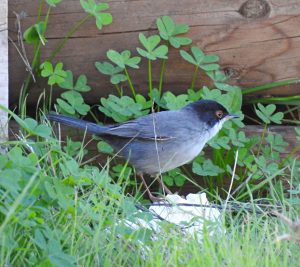
Present all year round in Extremadura, it is a typical inhabitant of Mediterranean scrubland, as well as meadows, hedges, brambles, gardens… The male is unmistakable for having a grey back, a black head and a red eye ring. The female has duller colours with a grey head and brown back. This small bird feeds mainly on insects, although it can also eat berries and wild fruits. It is distributed throughout the region with a healthy and increasing population.
Song thrush Turdus philomelos
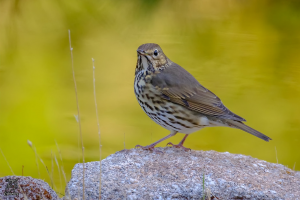
One of the most common Mediterranean scrubland birds, comes in winter in large numbers to Extremadura. The population is still abundant, although it has been greatly reduced by over-hunting. It feeds on small invertebrates as well as fruits, berries and seeds, being very common in pastures, scrublands, olive groves, vineyards… It also frequents forests and adapts to practically any type of environment, provided that there are trees nearby.
Spanish sparrow Passer hispanoliensis
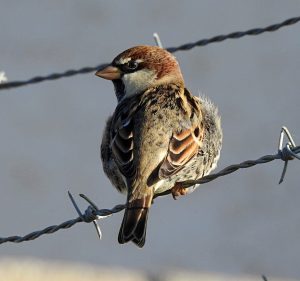
A very gregarious species that feeds mainly on plant matter. It is especially abundant in Extremadura, where most of the population of the Peninsula is found. In winter they carry out micro-migrations to warmer areas, in our case the populations in the north of the Iberian Peninsula migrate to Extremadura and Andalusia. Their population is undergoing significant growth due to their great capacity for adaptation. Females are very difficult to distinguish from the House Sparrow. In the case of males, they lack the grey crown and the black bib extends over the breast, as well as black stripes on the back.
Spectacled warbler Sylvia conspicillata
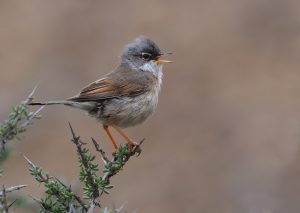
A fairly abundant warbler species that visits our country in spring/summer to breed and then migrates to Africa in winter. More abundant in the province of Cáceres than in the province of Badajoz, it has a predilection for areas of Mediterranean scrub, although it can also be found in open juniper and sabine woodland and in periurban areas. Small in size, it is characterised by a reddish-brown band on its wings, and males have a dark grey head and white throat. Like other warblers, it feeds on insects and some fruits and seeds.
Spotless starling Sturnus unicolor
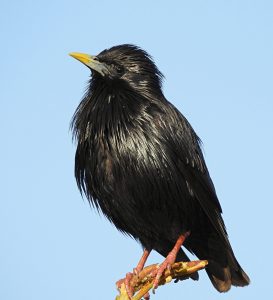
We include this well-known bird in Mediterranean scrubland birds, although we can find it in all kinds of habitats. Very abundant throughout Extremadura and the Iberian Peninsula, it is one of the most typical birds of our towns and cities but also of pastures, forests, steppes, crops… It is closely linked to man as it feeds on fruits and seeds as well as invertebrates, often linked to livestock. It is easily identified by its black plumage (young birds are usually brown) and its beak is yellow in summer and dark in winter.
Stock dove Columba oenas
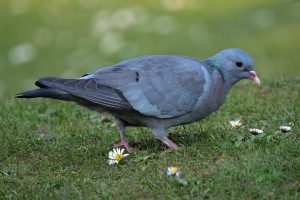
Much smaller in size than its relative the wood pigeon, the elusive stock doves are not particularly abundant in the region. Changes in agricultural practices do not benefit them and, unlike the wood pigeon, their populations are in clear decline. Part of the population lives all year round and another part comes in winter from northern Europe. It can be seen in cultivated areas, pastures… and makes its nests in trees as well as in stone cuttings or ruined buildings. Unlike the Rock Pigeon, they do not like human presence and try to avoid it.
Swallow Hirundo rustica
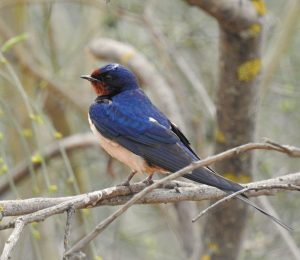
A typical bird of our villages, present in practically all of them, is accustomed to nesting in all types of buildings in the rural world. Its diet is mainly composed of insects, at the end of the summer it returns to Africa to spend the winter. It is very abundant although the generalised use of insecticides is also having a negative impact on its populations. It can also be seen in small colonies near wetlands, especially in summer.
Western orphean warbler Sylvia hortensis
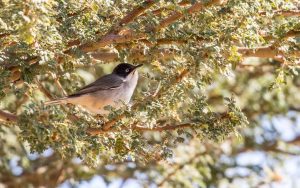
It is the largest Extremaduran warbler and is characterized by its black mask, dark cap and prominent pale eye. This warbler has a predilection for holm oak woodlands and warm open forests, denoting its presence with its song. It is more comfortable among the treetops than other warblers, more accustomed to moving through the undergrowth. It feeds on insects and small wild fruits during the warm months and in winter migrates to Africa. The population is not endangered and is present throughout the region, provided that the above-mentioned habitats exist.
Woodchat shrike Lanius senator
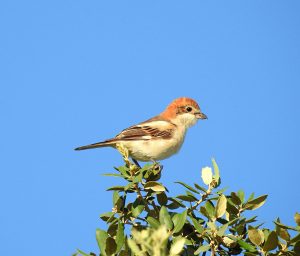
This small predator is characterized by its red “beret” and by nailing its prey to barbed wire or thorny bushes. It feeds on both invertebrates and small vertebrates, and is common in woodlands and various types of forest. It is a summer bird in the Iberian Peninsula. The populations are in slight decline due to the transformations of the rural environment in the last decades. Even so, it is still an abundant species and is distributed throughout the community.

